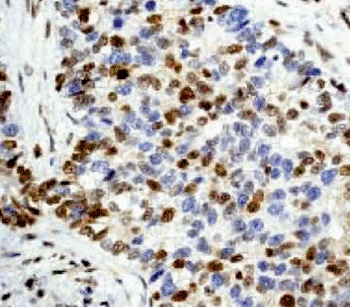Clinical Test Sought for Breast Cancer
By LabMedica International staff writers
Posted on 04 Sep 2013
Women who give birth in their early twenties are less likely to eventually develop breast cancer than women who do not, triggering a search for a way to confer this protective state on all women. Posted on 04 Sep 2013
The global gene expression and epigenetic profiles has been investigated for multiple cell types from normal breast tissue of nulliparous and parous women and carriers of breast cancer gene one (BRCA1) or breast cancer gene two (BRCA2) mutations.

Image: Immunohistochemical analysis of paraffin-embedded human breast carcinoma stained with p27 KIP 1 antibody (Photo courtesy of Abcam).
An international scientific collaborative team led by the Harvard Stem Cell Institute (Boston, MA, USA) compared numerous breast tissue samples, and found that women at high risk for breast cancer, such as those who inherit a mutated BRCA1 or BRCA2 gene, have higher-than-average numbers of mammary gland progenitors.
In general, women who carried a child to full term had the lowest populations of mammary gland progenitors, such as p27+, even when compared to cancer-free women who had never been pregnant. In addition, in woman who gave birth relatively early, but later still developed breast cancer, the number of mammary gland progenitors were again observed to be higher than average. There was a significant reduction in the frequency of CD44+p27+ cells in parous women and showed, using explant cultures, that parity-related signaling pathways play a role in regulating the number of p27+ cells and their proliferation.
Kornelia Polyak, MD, PhD, the senior author of the study, said, “The reason we are excited about this study is that we can use a progenitor cell census to determine who is at particularly high risk for breast cancer. We could use this strategy to decrease cancer risk because we know what regulates the proliferation of these cells and we could deplete them from the breast." Prof. Polyak added that if the hypothesis is confirmed, likely within a few months, the commercial development of a clinical test for breast cancer risk would follow. The study was published on June 13, 2013, in the journal Cell Stem Cell.
Related Links:
Harvard Stem Cell Institute








 (3) (1).png)
 Analyzer.jpg)



